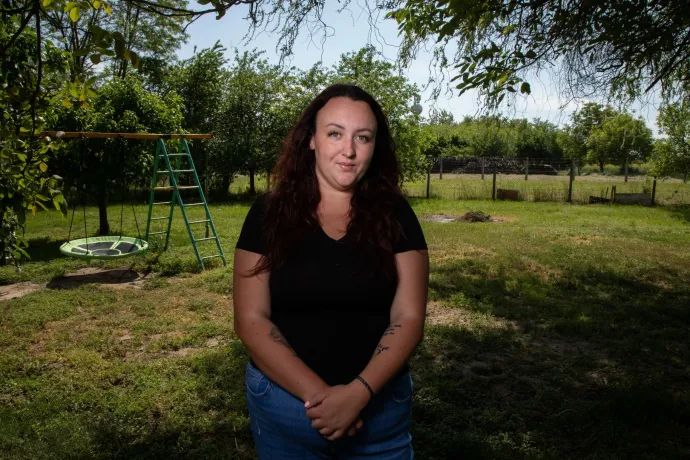Hungary's current family policy draws a dividing line between the "deserving" and the "undeserving"
July 07. 2022. – 01:15 PM
updated

"I want to reach a comprehensive agreement with the women of Hungary. I think it is important for them to let us know – and for us to understand – what they want," said the Prime Minister four years ago, articulating his point of departure for demographic policy. But just what sort of impact have the state's childbearing incentives – which in terms of GDP is high even globally – had, and what demographics are considered worthy of receiving support?
Ramóna Gall-Horváth and her husband had been trying to start a family for four years – unsuccessfully. She managed to become pregnant three times but miscarried two of the fetuses around the sixth week and the third after its first heartbeat. Doctors were unable to determine the cause of the miscarriages, so in early 2020 she made an appointment for an examination at the Dr. Domány Sándor Human Reproduction Center of the Kaposi Mór Teaching Hospital in Somogy County. After six months of waiting, Ramóna and her husband managed to get seen: the couple went through the routine procedures and were found to be in perfect health.
Meanwhile, a distant, non-blood relative told them that she was pregnant but did not want to keep the baby and was planning to leave it at the hospital. Ramóna tried to give the expectant mother all the help she could. Both she and her husband offered their support, but the woman was adamant. So the couple made a decision: they would adopt the baby. At the same time, following many long months, Ramóna finally got an appointment for a laparoscopic tubal patency assessment at the Fertility Center, but she didn't go because by then – after almost five years without success – she and her husband grew weary of the whole affair and decided to pursue adoption.
Since they were kin to the mother, their waiting time had been significantly reduced, which would have otherwise been years. While waiting for the baby's birth, they underwent psychological testing and prepared themselves for parenthood. Ramóna hadn't been paying attention to her own body's signals, and one day she was met with a big surprise: her pregnancy test came up positive. It didn't take her and her husband long to make up their minds: they would raise both children.
WOMEN, HUNGARY, 2022
How can women thrive in Hungary? What are their prospects of landing a job, having children, and getting health care? What has Hungary been able to achieve so far with regards to violence against women and the underprivileged? In this five-part series, Telex takes a look at the situation facing women today in five different settings.
If you think it's important that we look into the issues affecting our society as a whole and produce more of such content, consider becoming a supporter!
Ramóna was three months pregnant and had just made it through the discomforts of the first trimester when Hanna was born on January 6th, 2021. She even managed to be present at the baby's birth and name her. Six months later, Maja was born, and although the first year was not an easy one for Ramóna – especially as her husband works abroad – her mother helped her through it all. She has been able to make the most of state benefits: she has received CSED [infant-care allowance: expectant mothers who meet the requirements are entitled to up to 24 weeks of paid maternity leave, during which they receive 100% of their current average earnings] and GYED [child-care allowance: from the end of the maternity leave period until the child's second birthday, either parent (who meet the requirements) is eligible for parental leave, during which they receive 70% of their current average earnings (up to 70% of twice the minimum wage, making 280,000 forints or roughly 700 euros per month)] for both children – and is currently still receiving double of the latter. She has received the birth grant for both children [a single lump-sum payment of 225% of the minimum state pension, which in 2022 amounts to 64,125 forints or roughly 160 euros], and this year she received a tax refund. Now she and her husband are of the mind: "Where there is room for two children, there will be room for a third."
A flawed approach that does not achieve what was hoped for
So despite the fact that Ramóna had to go through the traumatic experience of a miscarriage – along with a quarter of Hungarian women, according to some studies – she did not end up having to undergo lengthy infertility tests and procedures, and she was still able to have her baby. Their adoption also constitutes a special case as a result of their family connection. It saved them from years of uncertainty and waiting. And her status in the labor market prior to her parturition enabled her to receive the maximum government benefit available to mothers.
Married women and their families are among the primary beneficiaries of Hungary's current family support program – a program that helps the middle class (i.e. not all Hungarian families) to have children. In a study conducted by socio-political expert Dorottya Szikra, this is referred to as selective pronatalism, implying that the aim of the current family policy is not to help communities that are marginalized or lagging behind or to keep children born in Hungary out of poverty but rather to encourage families deemed "suitable" by the government to have (more) children.
Support of this kind for families stands in stark contrast to the means-tested benefits system. The best examples of this are the family tax credit for children and the family tax refund that was paid out this past spring. These forms of support specifically favor those who are better off over the more vulnerable (the unemployed, those with unreported employment, and those living in extreme poverty) – as opposed to the family allowance (which is available to all families), GYES [child-care assistance provision: a financial aid program designed for parents of children under the age of three], or GYET [child-rearing support: a financial aid program designed for parents of three or more young children]. Moreover, the size of these benefits increases not only in proportion to the number of children but also to income.
Melinda Bán, founder of a financial advisory site for young mothers in Hungary, points out that many families do not qualify for the infant-care and child-care allowances because not only do mothers need to show proof of having at least 365 days of insurance coverage in the two years prior to giving birth, they must also be insured when applying for the benefits – and this is often not the case for the most vulnerable groups of society.
Szikra believes that this type of pro-childbearing policy (which draws a sharp dividing line between "deserving" and "undeserving" social groups) was conceived in the spirit of post-communist traditionalism, according to which many people fall into a category that renders them undeserving of state (social) support. On top of this, the state has let the benefits depreciate over the years: the child-care assistance provision has remained unchanged at 28,500 forints since 2008 [today it is equivalent to approximately 70 euros], which was 40% of the minimum wage at the time, but in 2020 amounted to just 18%.
Éva Fodor, sociologist and deputy rector of CEU, believes that the very concept of subsidization is flawed because its primary goal is that of increasing the number of births.
"In fact, it's not mothers who are made the focal point – if women's interests were being taken into account, then the government would also be improving institutional systems with the same vigor
– the healthcare system, medical services, maternity facilities, educational institutions, and the operation and accessibility of nurseries, kindergartens, and schools. Instead, the focus is on an imagined model family that conceives several children and possibly consists of multiple generations living together."
That said, the child-care allowance currently available to mothers, fathers, and grandparents could be a good initiative in principle since it is offered from when the child is six months old. The GYED Extra scheme also allows mothers to return to the labor market, if they wish, while still receiving benefits. However, in the small, disadvantaged settlements around the country, the child-care allowance is precisely what undermines the employment opportunities and support of women, as it is often the fathers who opt for the allowance – after all, they are entitled to a much higher sum than women. Yet in reality, it is still the women who – rendered completely vulnerable and without any form of care – stay at home in these families and look after the young child(ren).
"Contrary to popular belief, the policy that Orbán's government is pursuing is not a conservative one in the classical sense. Rather, it is one impacting gender and equality in society that not only aims to make women more active reproductively speaking and care for more children but also to take part in the labor market
– and this in turn deepens gender inequalities. It also puts the onus on women to care for the elderly," says Fodor.
Research has shown that increasing the employment rate of women with young children has a positive effect on the propensity to have children, but a prerequisite for this would be the establishment of childcare facilities. Thanks to the nursery school development program, the capacity of such facilities has increased by 8%, and institutions have been set up in every district. However, they are rather unevenly distributed: in many parts of the country public institutions have limited capacity, and childcare professions suffer from acute labor shortages and precariously low wages.
But the system also has its shortcomings that affect all classes. Although Ramóna receives the so-called "sibling-care allowance" (i.e. she is entitled to benefits for both children), this is not available to mothers who have given birth to twins. Melinda Bán points out, "With twins, families receive extra assistance, in the sense that the child-care allowance can be claimed until the children are three years old (instead of two). Following this, they can receive the child-care assistance provision until the children are old enough to start school (instead of the age of three). However, they only receive a single payment of the infant-care and child-care benefits, even if they have several children at the same time."
Housing subsidies that are included in the family support schemes have also become an integral component of public measures. Their purpose is to increase the number of children and encourage parents to have a third child – rather than support poorer families. However, it is telling that although CSOK [family housing allowance: a financial aid program designed to support couples in proportion to the number of children they already have or plan on having] had been introduced in mid-2015 and by the end of 2021, about 206,000 families had received 656 billion forints (~1.6 billion euros), statistics show that 82% of families claiming the three-child subsidy already had three children at the time of application. Since the start of the program, 65.4% of claimants have applied for the subsidy exclusively based on the children they already had, while only 2% of childless couples have committed to having at least three children. The project is nevertheless undoubtedly successful in that 34.6% of the benefit's claimants promised to have at least one more child.
Births are down, but Hungary takes gold in marriages
According to an analysis of family policy by the State Audit Office of Hungary, the country is using these subsidies to ensure that families can actually have every child that they plan on having. This is because, according to an OECD survey, the number of children that citizens of the EU would like exceeds 2.1, which means that if said children were born, population decline could be halted even without immigration.
But the data tells a different story. Although birth rates across Europe showed a remarkable increase in 2020-2021 (in contrast to the period 2017-2019, when the government was already providing significant financial support to encourage people to have children), by the first quarter of 2022 there was a dramatic drop of 12% compared to the prior year. The number of live births was below 20,000, a record low since modern-day statistical recordkeeping was first introduced. While many attribute this to fears associated with vaccination, there are in fact fewer women of childbearing age in the country, and currently there are not enough of them to bring birth rates back to the levels seen in the 2000s, let alone to those prior. On the other hand, the propensity to have children may be greatly affected by the fact that women are considerably worse off in the labor market after having children: during this period of absence their careers often lose momentum, and they are put at an irreparable disadvantage. On top of that, the vast majority of workplaces still do not offer flexible working hours to women returning to the workplace.
Meanwhile, the state intends to encourage family formation not only through government measures but also through a strong shift in public opinion. They believe that the solution lies in defending gender roles as well as the (heterosexual, nuclear) family model based on marriage between men and women – where "the mother is a woman, the father a man" – (well, not everyone agrees: one Fidesz MP, for example, said that a lack of green space was more to blame for the low birth rate).
And it's first and foremost women who the current government puts the responsibility for having children on.
But it does seem like the subsidies (tax credits for first-time married couples, the family housing allowance for the children of such couples, prenatal loans) have achieved their aim of increasing the propensity to marry. According to KSH data, a 35-year-old record was broken in 2021: the last time the number of marriages was as high as this year was 1986. Even in 2020, Hungary already had the highest number of marriages in the European Union, with 51,000 of these taking place between partners that had never been married before. Yet another success is that the fertility rate – the average number of children a woman has in her lifetime – has risen from 1.56 to 1.59. The last time it was higher than this was in 1994. In particular, the proportion of children born out of wedlock fell to 30.5% by 2020 – a big change considering the upward trend that had been observed since 2015. At that time, almost half of all newborns (47.8%) fell into this category. Even compared to 2018-2019, the growing preference for marriage before having children is strongly visible: in 2018, 44.3% of mothers gave birth without a marriage certificate, but in 2019 only 38.9% did so. Among the marriage-related benefits for families with children, this trend is most closely linked to the introduction of the prenatal loan in July 2019. The success of the scheme is illustrated by the fact that the amount disbursed exceeded 1.5 trillion forints (~3.6 billion euros) last year. However, it is precisely this form of lending that is responsible for the fact that many people are stuck in a dysfunctional marriage only because they would not be able to pay back the loan due to its huge interest rate penalty in the event of divorce.
As Fodor puts it: "The current approaches are short-sighted, the long-term effects cannot yet be anticipated, and many people do not even stop to think about the possible consequences. A very important principle at the heart of the measures is family and caregiving – this is the basis on which the state offers support. It is the so-called 'carefare model' – a stunningly exclusionist mechanism based on the obligation to provide care. It does not favor individuals but unions of heterosexual men and women who have young children, earn well above the minimum wage and work in the formal labor market – it is only they who are considered families. And yet this only includes less than thirty percent of the Hungarian population. The government's only concern is to see more children being born. But even if this happens, very few measures have been put in place to help families raise the children after they turn the age of three."
At the time when the notion of the country's economic recovery was linked to the steps to restore the traditional family model and increase the number of children, the government launched a fight against gender equality ("gender ideology") and sexual minorities. In March 2021, a law came into force stating that the only children that can be "offered" for adoption to single people are those who have been turned down by couples who want to adopt all over the country. Then, only the Minister of Family Affairs, Katalin Novák, could sign off on the placement of a child in state care with a single parent. And after the appointment of Katalin Novák as Head of State, the responsibilities associated with family law were taken over by the Minister of the Prime Minister's Office, Gergely Gulyás. And last year's government decree amending the conditions for adoption made it incredibly difficult for single individuals wanting children – and indirectly, made it impossible for same-sex couples. This was done because "giving preference" to married couples would allow adopted children to "grow up in a truly lasting communion of love."
The question of having children is no longer such a private matter. This is to such an extent that infertility centers have been brought under state control, and private institutions have been denied the right to continue operating. The government abolished them on the grounds that it wanted to prevent corrupt practices, but this claim bears no professional basis in reality.
But in public institutions, patients have much less time face-to-face with service providers, and the quality of care is not particularly high. As Ramóna's example shows, most places have long waiting lists, which is why it is incomprehensible that the state is letting two well-equipped clinics go to waste. After all, time is the greatest enemy of a woman struggling with infertility. One international trend that is also prevailing in Hungary is that the age at which women are having their first child is getting pushed back further and further: the average age of a woman at the birth of her first child in 2020 was 28.92 years old, and when considering all births, the average age of a woman at the time of childbirth was 30.3 years. (In the 1980s, a woman gave birth to her first child at 22.86 years of age, and the average age at childbirth was 24.95.) The infertility measures leave many people with no other option but to go abroad for the treatment they desire. According to private clinics, many people have come to them after having exhausted their five free state treatments or having passed the 45-year age limit. In addition, the sector's main problem is that there are not enough specialists in this subject. Their training in Hungary is completely haphazard and disorganized, with many having left for foreign countries since nationalization. As such, state institutions are likely to be even more overburdened than usual. And given the current family policy measures, single people will certainly find it more difficult or even downright impossible to access infertility treatments.
This article is the fifth and final part in a series of Telex articles on the situation facing women in Hungary today. You can find the first article here, the second here, the third here, and the fourth here.
If you enjoyed this in-depth piece, and want to make sure not to miss similar pieces in the future, subscribe to the Telex English newsletter!
The translation of this article was made possible by our cooperation with the Heinrich Böll Foundation.



